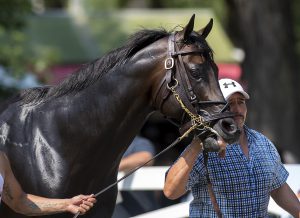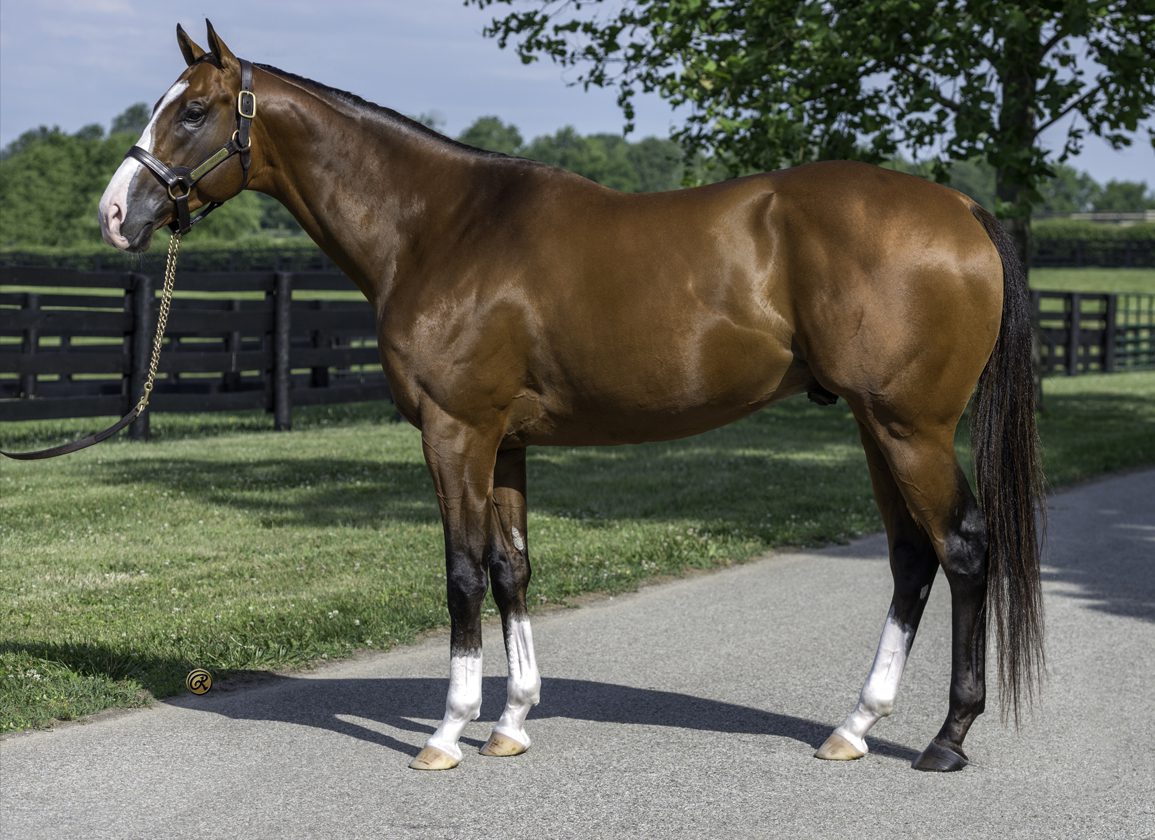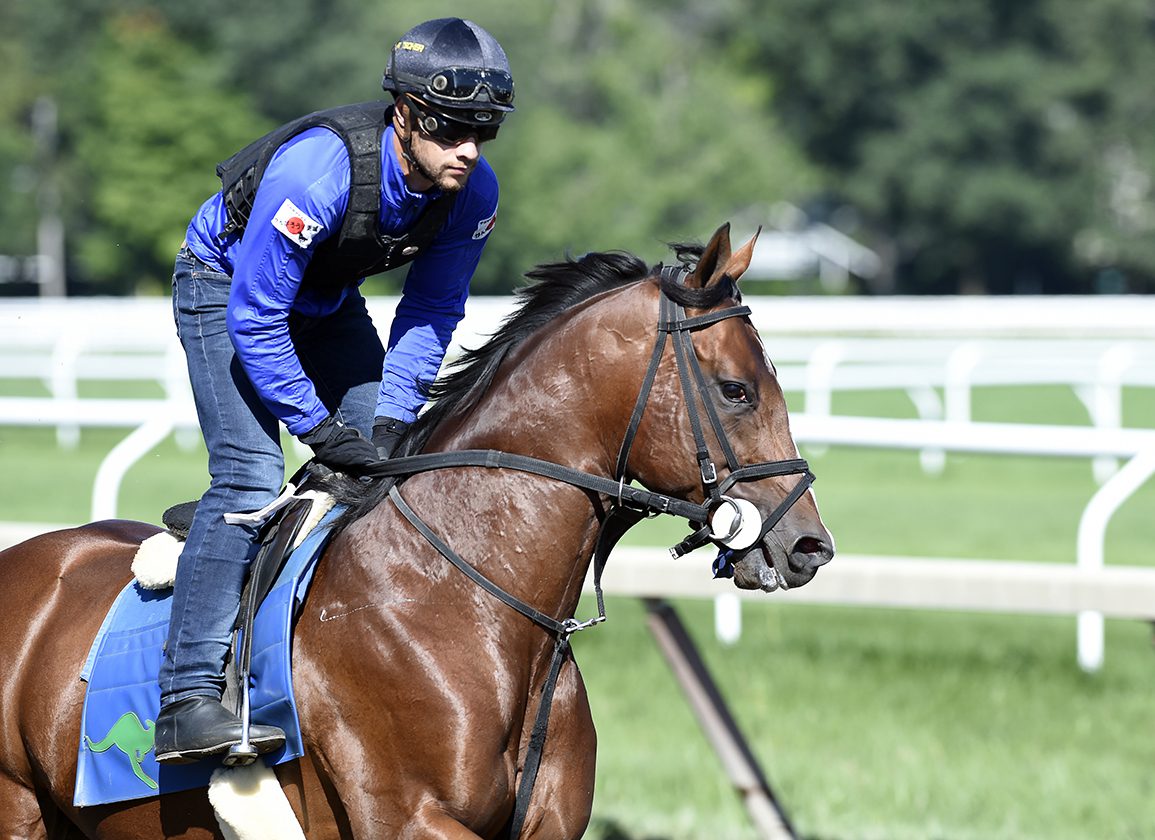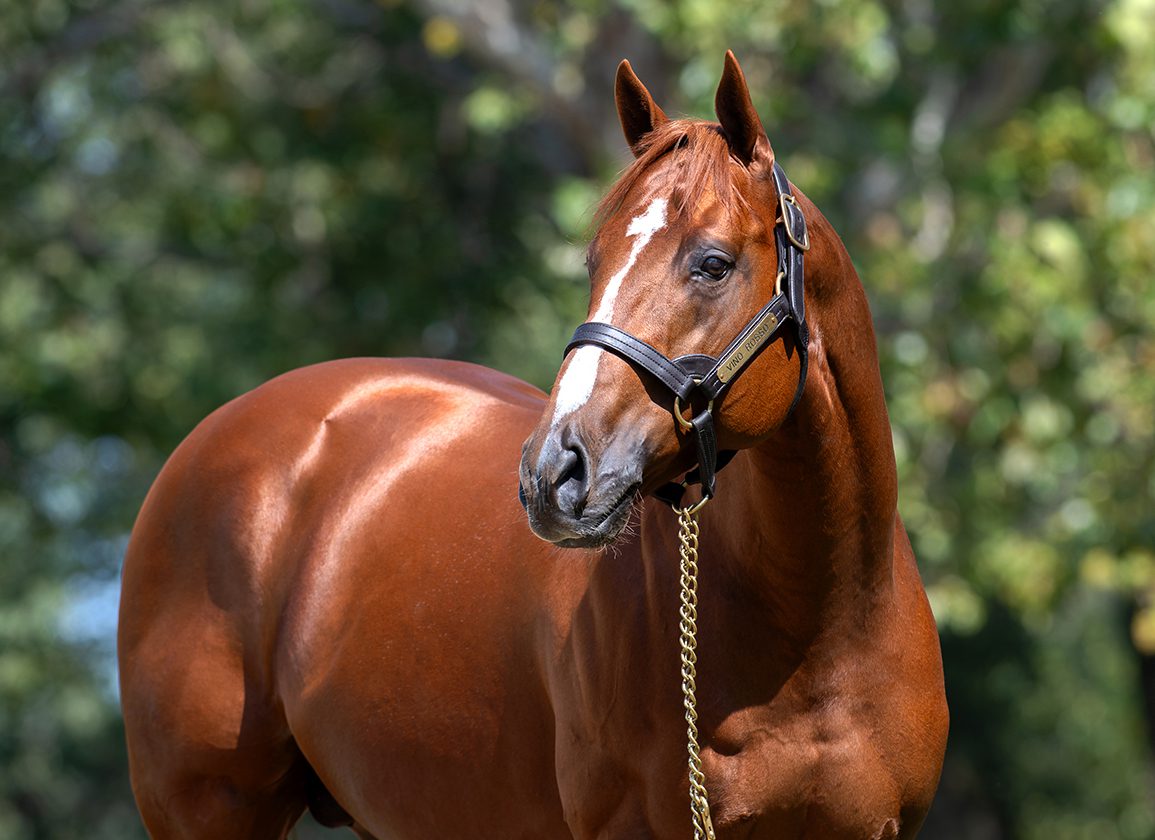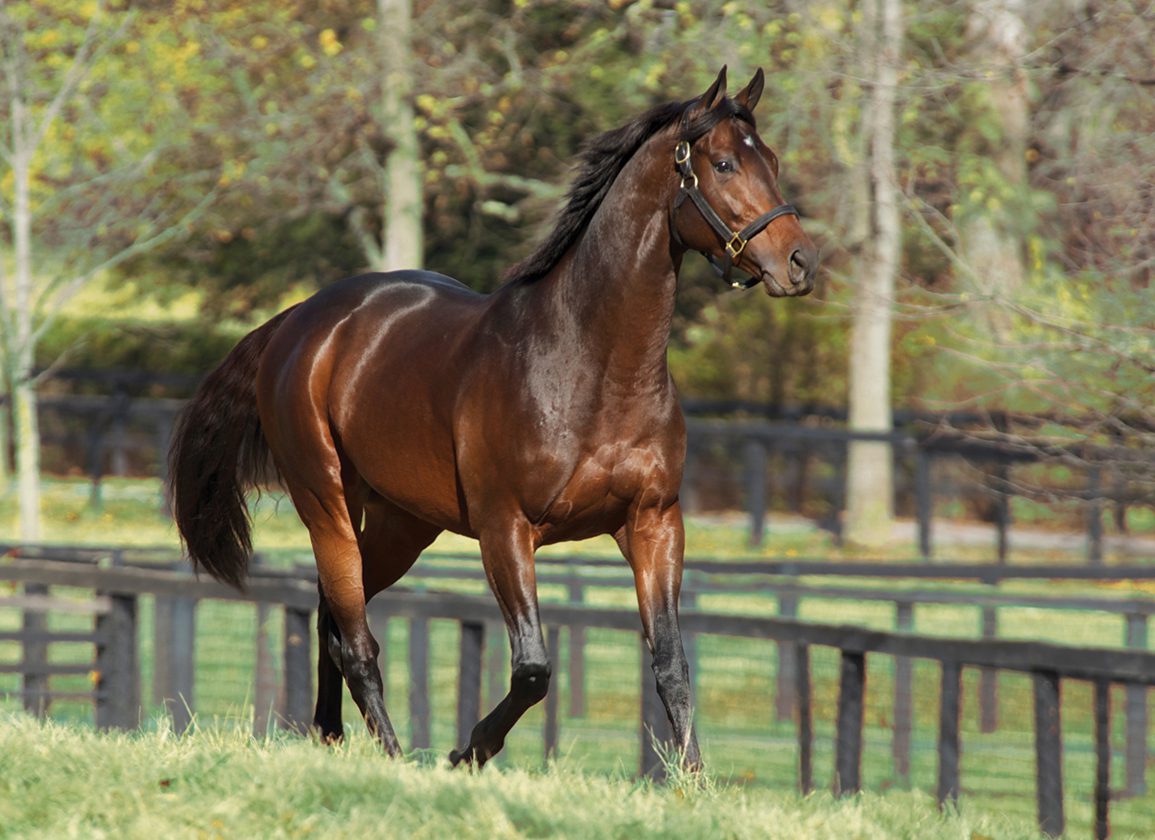His friend Spider Duignan knew that the stakes were high. When the horse coasted past the wire in the GII Saratoga Special, Duignan turned and said, “You needed that bad, didn't you?”
Deuce Greathouse was candid in his reply. “It was not an option,” he said, “for that not to happen.”
Raised the way he was, Greathouse knows that there are never any guarantees with horses. Since taking his cue that day, indeed, Rhyme Schemes (Ghostzapper) has himself demonstrated as much by coming up with an ankle issue shortly before the GI Hopeful S. There will be no Derby trail for him, then, though he appears highly eligible to pick up the Triple Crown pieces as a fresh horse in the summer.
And at least he did what was required, that crucial day at Saratoga.
“It did not cross my mind,” he says of the idea that Rhyme Schemes might not follow up his stunning maiden success at Ellis Park. “I would not allow myself to imagine how bad a spot I was going to be in, if that horse didn't win the Saratoga Special. Because that's just the way we play, that's the way we're in the game.”
Rhyme Schemes is a flagship for Pura Vida, a partnership Greathouse has put together over the past three years or so. As we'll hear, it's definitely a program tailored to the modern marketplace. At the same time, however, it adapts a precious legacy–and not just the horsemanship inherited by the whole clan, long associated with Glencrest Farm.
Greathouse remembers Rusty Arnold saying that his father David, lost at just 63 in 2013, was the only person who still “did everything.” He raced horses, gambled, bred and consigned, sold shares and seasons. In other words, it was action all the way; and it was all about the action.
“A lot of the older guys have told me that I'm kind of the last of a dying breed, as far as the real gambling side of the racing,” Greathouse remarks. “Now a lot of my good friends are pinhookers, and they've got their farms and everything. But you don't really see the guys that just live gambling, just buying and trading horses like we used to.”
And that's why he suspected that there might be a niche for something like Pura Vida. Too many partnerships, he felt, were too woolly and discouraging in their aspirations. He wanted players who would tease out the odds: hedge here, roll the dice there, try to offset the investment as they went along.
“It's like all these people that are getting in are basically being told, 'Hey, you got to love the game so much that you're willing to burn $50,000, or whatever,'” Greathouse says. “And I just thought that was B.S. I mean, most of us that make a living in the horse business never start racing partnerships. You'll see a good guy try it once in a while, buy a few with a couple of buddies. They either have luck or they don't. But I grew up with gamblers. I mean, real gamblers. And a lot of the horses that we did well with, and sold, it was like I said: not doing well was not an option. Because if they didn't pan out, I was gone.”
That approach is bound to bring the odd bump in the road, but it also meant that Greathouse could fire up his resume with early involvement in names as illustrious as Tepin (Bernstein) and Shedaresthedevil (Daredevil).
In a way it was picking out the latter, when she failed to sell at Keeneland September, that satisfied Greathouse that he could and should make something like Pura Vida happen.
“I knew that the reserve was $20,000,” he explains. “So I stood next to WinStar and made sure nobody was going to bid that, let them haw and hem, and tried to get her for $15,000. But they wouldn't, so I took the $20,000. I was just trying to be cheap! But I was not going to leave without the filly. And when she broke her maiden, we sold [a majority share] based on $600,000.”
As a GI Kentucky Oaks winner, of course, she would bring $5 million at Fasig-Tipton on her retirement and Greathouse had, by then, long sold his remaining stake.
“But I'd do it again,” he insists. “I'd do it five times in a row. I had to, to make a living. And listen, I was proud to have done so. Of course, it would have been cool, to have still owned a piece of an Oaks winner. But when someone asked whether that was a little bittersweet, I could truthfully say no. What it did do, was make me decide that I needed to raise more money, and do this properly, if I wanted my partners to be able to keep pieces of their great horses.
“And that's what it's all about. You sell. I'm always going to sell, to prove to those guys we can keep it going. But now I can sell a minority piece instead. When I was doing it myself, I always had to lose any control. You make your money, but then you might have to watch horses railroaded by the wrong people, in how they handle them.”
Shedaresthedevil was trained to break her maiden by Norm Casse, who also handles Rhyme Schemes as Pura Vida's principal trainer. (Also on the roster are Mike Maker and Bruce Levine.) Greathouse and Casse got to know each other in the slipstream of Tepin, trained by Casse's father Mark. When Casse went solo, Greathouse promised him support–albeit he now questions quite how helpful he was being.
“I think Norm had 20 horses in training, and 10 were mine,” he says. “But I was trying to survive, and he had to deal with horses that I tended to have only because they didn't sell. They usually had some vet things, and you knew they'd be limited before they ever got going. So it was a tough job for him, starting out.
“I had tried to buy way too cheap: most were 10 to 20 grand. And that really helped change my opinion on exactly how to do it. You still have to be very sharp about what you pay, but you don't want to force yourself to buy at too low a level. It can work, but it's not going to work every year. And, to keep going, this needed to come up with a good horse every year.”
They now seem to be managing just that. Bankrolled initially by Brett Setzer, Cindy Hutson and Greathouse, with some back-up from Tom Romano and Alan Usher, the budget was upgraded to around $370,000 on seven horses. In the buyer's market of the pandemic year, Greathouse “was really just looking for nice fillies in the back ring and letting it all kind of fall together.”
Ontheonesandtwos (Jimmy Creed) was one of those, sent to Casse as a $37,000 Keeneland September yearling.
“She was out of a Malibu Moon mare that could run some but didn't have a lot of page,” Greathouse recalls. “After she broke her maiden, we sold a third for $200,000. We had another filly that ran second at Saratoga on debut. We'd paid $42,000 for her, and sold a quarter for $75,000. So they kind of got it going, showed people what could be done if somebody's picking them out that knows what they're doing.”
To secure which advantage, partners in Pura Vida commit to leaving decision-making to its founder.
“It's for their own protection,” Greathouse explains. “I still talk to everybody, see what they're thinking, and try to make decisions–when I can–based on what the group wants. But it protects them from me making a mistake, and letting somebody into the partnership that proves a real pain in the ass! I grew it very slow on purpose, because I knew the group really enjoyed each other. Obviously that helps you strengthen and build. If I tried to build too quick, let a bunch of people in, it could ruin the whole culture.”
Greathouse and his father had always been amazed by the presumption of successful people who enter this arcane and challenging environment expecting to nail it overnight.
“My dad always used to laugh about these guys,” Greathouse says. “They come in and they have a plan. And they know nothing. Men and women who made a fortune doing other things on sound business principles, they get into this, they get in front of the lights and throw everything out the window. And then a few years down the road they're bitching about bills, and wanting to blame you!”
Both funding and discipline were in place, then, by the time Greathouse came across a Ghostzapper colt in the Paramount Sales consignment at last year's Keeneland September Sale.
“I believe he was the very end of Book 2,” he recalls. “That's kind of where my price range started in that sale: everything I bought came between there and Book 3. This time round, it took until the very end of Book 3 to buy one or two, and then we bought everything in Book 4! So you just have to deal with what the market gives you.
“Anyway he's a gorgeous horse. In all my years, pinhooking and everything else, somehow I don't think I've ever owned a Ghostzapper. And, as I said, our focus is always on fillies. But I had a little more money to spend, so wanted to add a couple colts. You never know, you might come up with a Derby horse in the package without trying to buy 10 colts a year on a feast-or-famine deal.
“He was my kind of horse: medium-sized, pretty head, extremely well balanced. That hind leg, which I learned from Ciaran and Amy Dunne, that we all look for when buying for the 2-year-old sales. And not too heavy. I've stopped trying to buy heavier colts. They just don't hold up. You trick yourself into these big, gorgeous colts–but they're just not sound. Certainly they can't have a heavy neck because, to me, that's just all weight on the knees. I mean, $210,000 was a lot of money for me, so he had everything I liked in a horse.”
As usual, Geoff Mulcahy was entrusted with the colt's education.
“As far as I'm concerned, the earliest any of them will ever run is April or May,” Greathouse declares. “So I don't want to pay to ship them all to Florida and ship them all back here. Geoff does a great job. I'm out there three or four mornings a week in the winter watching them train. That allows me to see how they're doing–which need to be turned out, which we go on with, which trainer might suit them best.”
The Ghostzapper colt was always obliging, equal to anything he was asked.
“Didn't matter if you breezed him with a really good horse, or a mediocre one,” Greathouse says. “He never let them get ahead of him. At the same time, he never blew you away. He did everything evenly. With Geoff, we do a lot of two-minute licks, a lot of slow three-eighths. We just build them up and then let them gallop out. So you build a lot of stamina in the babies.”
Sitting down with Casse in the spring, they agreed that a horse of this kind of cost and profile shouldn't be cranked up to explode into the shop window on debut. So Rhyme Schemes was left space to learn from his first experience at Churchill in May.
“He was fit enough to run, but by no means sharp,” Greathouse recalls. “And when he didn't break, and that stuff hit him in the face for the first time, he just kind of ran around there. You didn't necessarily know what to make of it. But he came back a little stronger, we put blinkers on him. And I will say that Ricardo [Santana Jr., jockey], when he breezed him after that first race, said that nobody was going to beat him next time.”
They went to the windows, sure enough, but nobody was expecting to see something quite so electric.
“He just flapped the reins on his neck, and all of a sudden he's gone,” Greathouse marvels.
And it was exactly the same at Saratoga, when even the winning margin was identical: 9 1/2 lengths.
To recuperate from his setback, Rhyme Schemes has gone “home” to Duignan's Springhouse Farm. (Duignan not only helped to consign the horse as a yearling but is nowadays a syndicate partner). The team was never going to take risks simply for the sake of a little Derby fever.
“We're going to go take our time with him and hopefully have a good 3-year-old,” Greathouse promises. “Knock wood, he's been a great patient. He has an incredible mind, and that has been so helpful. When they're high-strung and stupid, they just hurt themselves again.”
In the meantime, there's much else to keep the Pura Vida team excited.
“We've four or five fillies we really like that haven't run yet,” Greathouse says. “There'll always be a couple that won't work out. But that's kind of the point. My job is not to have any pride, to identify those that need to come off the payroll so that the good ones aren't covering them.”
Whatever happens, a runaway Saratoga Special winner is quite a find among no more than 10 recruits.
“I don't analyze the crosses so much,” Greathouse says of his catalogue work. “We should all know, just from doing it our whole lives, which ones work. Really I just try to look at a pedigree and say, 'Would it shock me if this page produced a racehorse?' Whether there's two dams there that are basically blank, but it's an incredible family below; or whether a family is pretty weak on the bottom, but the mare could really run herself.
“My dad also always told me that a mare can make her own pedigree. A stallion can't. You don't see stallions with no page making it. But he said, 'You see fillies all the time that were just freaky racehorses, out of nowhere, and that's basically the bottom of the family tree.'”
The one thing any Greathouse will always have, of course, is a great pedigree of his own.
“Dad's friends would tell you that it was almost weird how close he and I were,” this one recalls. “I mean, we were together 24/7. So in the amount of time I had with him, I guess I absorbed everything I could. I'll never have his personality. I'm more of an introvert. But yeah, everything about the horsemanship side, and dealing with people, I learned from Dad. He was a legend, and his word was good. It's now 10 years since he passed away and even today, anywhere I am, I have people coming up to me saying, 'I still miss your father.'”
His Uncle John was a significant mentor, too, especially in the selection of young stock.
Overall Greathouse's orientation was always towards the racetrack, meaning that it worked out ideally when his cousin, the younger John, found himself drawn to farm life.
“So I kind of branched away [from Glencrest],” Greathouse explains. “John had gone to the Irish National Stud, he'd really learned a lot in a short period, and he loved foaling, which I never did. What I loved was getting them from weaning, prepping them for the sales, and then breaking them: just anything going towards the racetrack.”
The Pura Vida brand, which borrows Costa Rica's catch-all salutation, was chosen for its upbeat vibe. Because this is a program that likes to get on the front foot, trying to force gaps in the market.
“You're constantly having to buy new horses with money you make,” Greathouse says. “And the expenses that come with them are getting more and more insurmountable. But from the time I was little, you don't buy racehorses to win a maiden race. You're trying to hit a home run. And there's got to be something about that horse, whether you buy it for $20,000 or $500,000, that makes you really believe; that makes you feel there's a something in there that could turn out to be a little bit special.”
The post Greathouse Schemes for Action All the Way appeared first on TDN | Thoroughbred Daily News | Horse Racing News, Results and Video | Thoroughbred Breeding and Auctions.
